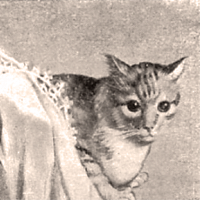Today it is largely done as a Counted Thread Technique but in the past (as even now) some do it as a classic embroidery technique, that is with traced designs on the fabric to be executed not by counting ground threads.
Going through the museums all over Italy I found extant pieces of this technique dating back quite far. There are pieces of fabric with Punto Antico elements on them dating back to the late 15th century. The pieces are quite complex suggesting that the technique goes much farther back in time.
This is some work at the Collezioni Comunali d'Arte in Bologna:

Ancient pieces have almost the whole surface of the fabric covered in stitching while modern pieces are quite sparse in comparison though done with no less good taste. I like the texture, the bas-relief effect, it seems to me like carved marble. The openwork spaces balance the textured areas using chiaroscuro effects so that this mainly monotone embroidery does not suffer in the least for lack of colour. The curlicues are my favourite element.
Another piece from the Collezioni Comunali d'Arte in Bologna:

This is some work exhibited at the Palazzo Davanzati in Florence:

As with any embroidery technique, there are a number of ways to execute the stitches. Taking the curlicue (Punto Riccio) as an example: it is executed in three parts with a base of Double Running Stitch (or Stem Stitch or Cable Stitch or Back Stitch) which are then whipped with an Overcast Stitch for each base stitch and then the whole line is covered in Overcast Stitches done side-by-side to create a wonderful raised stitch. Time consuming? Yes! Worth the effort? Very much so! It takes a bit of practice..

My first ones were quite lumpy but after many attempts, they are pretty smooth now...

Here's what they look like over Stem Stitch with only one Overcast Stitch per Stem Stitch (overcast the overlap) ... This gives quite a different effect which is nice too.

Anyway, its a fun stitch to play around with, giving your work some texture.
There are some Punto Antico online tutorials at Tuttoricamo under the "How it's Done" section (Antique Stitch). While you're there you can download some old books on the subject from the "Books" section: look under 'downloadable Antique books' - L. Vannini, there are three there.
I did a couple of articles for Piecework which are available for download from their website.
For some modern books:
Associazione Il Punto Antico (all books are either in Italian/English or come with English inserts upon request).
Tombolo Disegni (click "books", "libri ricamo", "ricamo italiani" - you need to send an email request to order) There you will also find a book called Punto Antico disegnato which is not a counted thread technique book but rather designs for traditional freestyle or non-counted thread, Punto Antico embroidery.
Most of the Carmela Testa books at Iva Rose also have some elements of Punto Antico in them though the instructions are a bit vague.
Check out YouTube as there are some tutorial films there too!





I've just learned about your site through Yvette Stanton. Never having been introduced to Italian embroidery I am curious as to where one would start! Could you direct me to a beginner's technique/book/blog/tutorial????
ReplyDeleteMany thanks - it looks fascinating and I would like to know more.
Regards Eunice
PS I've entered Anonymous because I don't understand what the other profiles are...
Hi Eunice!
ReplyDeleteThere are many many types of Italian embroidery, since you are commenting under Punto Antico is that the kind you'd like to learn about first?
If you click on the Piecework link (in this post) there is a little biscornu project I wrote that is free to download. If you find you like this technique, then I can definitely recommend some books for you.
If you are not meaning Punto Antico can you tell me which technique you are most interested in learning about?
You can browse http://www.tuttoricamo.com/ (click on the British flag for the English pages) and then under "Techniques" - there is a lot to look at, and those are not all the techniques there are, only the ones they've had time to write about!
I look forward to hearing back from you!
p.s. I don't know anything about profiles either, I think - only if you sign in to Google can you then leave your name, but this works just fine!
Jeanine: I am a member of the Embroiderers Guild of America and our chapter has fallen in love with one of your projects printed online at Interweave (Piecework Magazine). We would love to present your Punto Antico Biscornu pincushion at one of our monthly meetings in Carlisle, Pennsylvania, with your permission. We would, of course, give you all the credit! I've left a message at Interweave, also, but thought I'd go straight to the source. Thanks so much for sharing your talents with the world! Please let me know if this would be acceptable to you.
ReplyDeleteDear Anonymous: Would you please contact me via my email addy (found in the top left of the page by clicking on "view my full profile")? A couple of other chapters of EGA have done the same thing and I have some other info to add which will make it better.
ReplyDelete